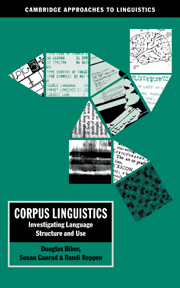Book contents
- Frontmatter
- Contents
- Preface
- 1 Introduction: goals and methods of the corpus-based approach
- Part I Investigating the use of language features
- 2 Lexicography
- 3 Grammar
- 4 Lexico-grammar
- 5 The study of discourse characteristics
- Part II Investigating the characteristics of varietie
- Part III Summing up and looking ahead
- Part IV Methodology boxes
- Appendix: commercially available corpora and analytical tools
- References
- Index
5 - The study of discourse characteristics
Published online by Cambridge University Press: 05 June 2012
- Frontmatter
- Contents
- Preface
- 1 Introduction: goals and methods of the corpus-based approach
- Part I Investigating the use of language features
- 2 Lexicography
- 3 Grammar
- 4 Lexico-grammar
- 5 The study of discourse characteristics
- Part II Investigating the characteristics of varietie
- Part III Summing up and looking ahead
- Part IV Methodology boxes
- Appendix: commercially available corpora and analytical tools
- References
- Index
Summary
Studying discourse characteristics
Discourse analyses focus on language characteristics that extend across clause boundaries. As a result, discourse characteristics are more difficult to identify and analyze than lower-level lexical or grammatical features. However, such analyses are important for both descriptive and applied linguistics. In fact, it turns out that the use of many lexical and grammatical features can only be fully understood through analysis of their functions in larger discourse contexts.
Most discourse studies identify salient discourse structures and exemplify those structures with illustrative text excerpts – such as identifying turn-taking structures in conversation or tracking the “themes” in a written text. However, it has proven difficult to apply these techniques to texts in a way that allows for generalizable results. Thus, although nearly all discourse studies are based on analysis of actual texts, they are not typically corpus-based investigations: most studies do not use quantitative methods to describe the extent to which different discourse structures are used, and relatively few of these studies aim to produce generalizable findings that hold across texts.
As a result of the lack of generalizable findings, we still know surprisingly little about the discourse similarities or differences across texts and registers. However, as the present chapter shows, corpus-based analyses can make a significant contribution in this area.
- Type
- Chapter
- Information
- Corpus LinguisticsInvestigating Language Structure and Use, pp. 106 - 132Publisher: Cambridge University PressPrint publication year: 1998

